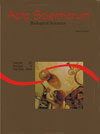<b>Road network and conservation conflicts in cerrado: a study for amphibian preservation</b>- DOI: 10.4025/actascibiolsci.171
Abstract
Building conservation units has been an important tool to minimize the loss of biodiversity. However, the allocation of these units need to be optimized to preserve the greatest number of species, under a series of socioeconomics restrictions that include the road network effect on biodiversity. An optimization process was made by using the “simulated annealing” algorithm, available on program SITES 1.0, to model a set of data on the distribution of 131 species of anuran amphibians occuring in Cerrado, distributed in 181 cells with 1º of spatial resolution. This study shows a couple of conservation units networks in Brazilian Cerrado, one of them based on the concept of complementarity and another on the distribution of roads. This paper points out the most important sites to create conservation units, attempting to preserve anuran amphibians from Cerrado and the places that should protect all anuran species spread on this biome, along the roads’ length. The results suggest that both networks should be used to combine conservation plans and human development, evaluated by means of road network.Downloads
Download data is not yet available.
Published
2006-11-16
How to Cite
Silva, R. de J., Vieira, L. C. G., Pinto, M. P., Oliveira, G., & Barreto, B. S. (2006). <b>Road network and conservation conflicts in cerrado: a study for amphibian preservation</b>- DOI: 10.4025/actascibiolsci.171. Acta Scientiarum. Biological Sciences, 28(4), 373-378. https://doi.org/10.4025/actascibiolsci.v28i4.171
Issue
Section
Ecology and Limnology
DECLARATION OF ORIGINALITY AND COPYRIGHTS
I Declare that current article is original and has not been submitted for publication, in part or in whole, to any other national or international journal.
The copyrights belong exclusively to the authors. Published content is licensed under Creative Commons Attribution 4.0 (CC BY 4.0) guidelines, which allows sharing (copy and distribution of the material in any medium or format) and adaptation (remix, transform, and build upon the material) for any purpose, even commercially, under the terms of attribution.
Read this link for further information on how to use CC BY 4.0 properly.
0.6
2019CiteScore
31st percentile
Powered by 

0.6
2019CiteScore
31st percentile
Powered by 











1.png)




3.png)













